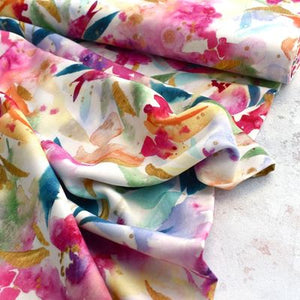Elastics are an essential notion you are sure to encounter regularly in your sewing practice. The vast number of elastic types and sizes available are closely matched by the variety of ways to use them in garment construction. But how do you know which one to use and where? Read on to learn how to recognize different types of elastic and their best uses so you can be sure you're choosing the perfect match for billowy-sleeved dresses, comfy waistbands, and lovely lingerie!

Sew Many Kinds!
The four main types of elastics are braided, woven, knit, and the larger category of specialty elastics. Each has their place in garment construction and best practices for using them, plus some tips and tools that may help make the process practically seamless.-
What is it? Commonly found in widths from 1/8" to 1", braided elastic is easily identified by its horizontal ribs that run the length of the elastic. This elastic narrows when stretched, can weaken when sewn through, and is best used on light to mid-weight fabrics.
-
Where do I use it? Braided elastic works well for necklines, sleeves, and narrow waistbands. Due to its sturdiness, it is a great option for garments that will worn frequently. It is also typically sewn into a casing because of its coarser texture, rather than exposed where it would brush up against the wearer’s skin.

2. Knit Elastic
-
What is it? Found in widths from 1/4" to 4", it is smoother in appearance than other elastics, with the telltale v-shaped knit pattern running through it. It is a stable knit that does not narrow when stretched and is also shrink-resistant. It is also best used with light to mid-weight fabrics.
-
Where do I use it? Due to its soft feel, knit elastic can be used in areas touching the skin directly, such as pajama pants, boxer waistbands, and headbands. It can also be sewn into casings or directly onto fabrics and does not weaken when sewn through.

3. Woven Elastic
-
What is it? Also known as non-roll, woven elastic is commonly found in widths from 1/4" to 3", and is exceptionally strong. It can be identified by its significant thickness and the horizontal and vertical stripes across the surface. It can be sewn through, does not narrow when stretched, and is primarily paired with mid to heavyweight fabrics.
-
Where do I use it? Woven elastic is perfect for waistbands, coats, and anything else which will need a heavy-duty, durable stretch that won't crush or roll! Due to its coarse texture, it is almost exclusively sewn into a casing on garments.

4. Specialty Elastic
-
What is it? This category consists of many elastics that don't particularly fit into the other three main types. It includes swim elastic, clear elastic, fold-over elastic (FOE), plush back elastic, picot elastic, and sometimes stretch lace elastic, elastic cording, and even elastic threads.
-
Where do I use it? Many in this category have somewhat limited uses in swimwear and lingerie. Others, like fold-over elastic and clear elastic, have a variety of uses. For example, clear elastic is excellent to have on hand to help stabilize hard-working seams when sewing knits. And elastic thread is used on a sewing machine as the bobbin thread when making garments with a shirred effect.
Sew Smart! Since elastics have fibers wrapped around spandex or rubber, take care when pressing garments that have elastic sewn into them. Always use a low heat setting and use a press cloth so you do not iron directly onto the elastic itself.
Top Techniques!
-
When installing elastic, it is best to reference the specific pattern you're using to see how they recommend to stitch it in place. Some sewing patterns will have the elastic sewn into a casing, while others will instruct you to sew the elastic directly to the fabric itself.
-
Does your pattern not specify which type of elastic to use? For narrower widths enclosed in a casing, use a braided elastic. And for wider elastics that are stitched in place (in a casing or not), use a knit elastic.
-
For stitching directly through elastic, use a stretch ball point needle, and be sure to use a stretch stitch, zig-zag stitch, or three-step zig-zag, depending on your machine and the pattern instructions.
-
Need help threading the elastic through a casing or waistband? We like to use a bodkin, which securely clips to the end of the elastic and easily feeds through the casing. In a pinch, a large safety pin also will get the job done!

-
When measuring elastic, always look at the pattern instructions for the recommended length. Waistbands are typically 2" to 4" shorter than the wearer's waist measurement. You can also check the length by trying it on, or if possible, you may want to try the garment on with the elastic in place before securing it. And always remember to add 1/2" to 1" to the length for overlap when sewing the elastic ends together.
-
When joining your elastic ends to make a loop, remember to overlap enough to allow for a strong connection. You can use a straight stitch here and sew several vertical lines or sew a box with an "X" in the middle for a strong hold.
-
When sewing elastic directly onto the fabric of a garment, keep in mind that the elastic will be a shorter length than the fabric it is being sewn to. Like adding a rib waistband or neck binding, split the fabric and elastic loop into quarters with pins, and stretch the elastic to fit as you sew. Remember when sewing them together that it is important that you stretch the elastic and NOT the fabric!
Sew Smart! Elastics tend to twist within their casings from time to time, but there is an easy way to avoid a wavy waistband! After you have sewn your waistband into its casing, stitch a few vertical lines along the side and back seams of your garment's waistband, carefully evening out the gathers as you go.
We SEW want to know what you think! What are some of the most creative ways you've used elastics in your sewing projects?







Leave a comment